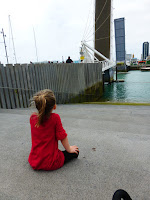“Childhood
is the most beautiful of all life's seasons.”
-Author
Unknown
Our family journey
to New Zealand this past November included our 3 1/2-year-old
granddaughter, Mila. We felt blessed to have her along. Ron and I
found that in some ways she was easier to travel with than our own
children were—probably because her parents were never more than a cell
phone call away.
Here are some
special times that Mila and I had together in this child-friendly
nation, south of the equator, and 6,500 miles from home:
On Mila's first morning in New Zealand (Ron and I arrived two days earlier) we headed out early to find the Up Cafe for breakfast. She asked for my map so she could pretend to help me find the way because I told her I was a little lost as usual. Once we found the restaurant, she ordered hot chocolate which she drank by the spoonful. It took over an hour to finish, and she did not want anything else to eat. Perhaps we could count the two marshmallows that came with it as breakfast.
When returning from Silo Park, located on the waterfront in Auckland, we arrived at the pedestrian lift bridge, Wynyard Crossing, just as the gate was closing. Mila quietly sat down on a nearby embankment and watched intently as the bridge lifted for a passing boat.
Whenever Mila and I were out together, she immediately gave us each an assigned name for the day. Most often, she was Elsa and I was Anna—characters from her favorite Disney movie Frozen. One day, when we were at a playground in Queenstown, Mila told a little Chinese girl that her name was Elsa, and then she held out her arm and told the girl's little brother to freeze when he was misbehaving. I just hope she doesn't use fictitious names when she's trying to make new friends in her neighborhood.
New Zealand is a wonderful child-friendly nation. In addition to numerous playgrounds, the restaurants often have little play areas or shelves full of children's books and toys. I also noticed that the locals took time to stop and visit with Mila. The museums often had areas dedicated to children. The world famous Museum of New Zealand Te Papa Tongarewa in Wellington, with its many discovery centers for children, provided hours of creative play for Mila and a much needed break for her parents.
We stayed at a lot of nice places on our journey. However, if Mila were to choose her favorite, it would be, without a doubt, the Red Tussock Motel in Te Anau. This is because of the little swing set (the kind that we had in the 50s and 60s) with just two swings and a small slide that she spotted immediately. I think it was the first time in her life that she had her own private swing set that she could enjoy to her heart's content.
We returned to
Auckland at the end of our journey shortly after Thanksgiving and the
beginning of the Christmas season. As Ron, Mila, and I were walking
along Queens Street on our last day, Mila noticed the colorful
animated window display at Smith & Caughey's. This
is the oldest and most loved department store in Auckland. They
decorate their windows annually for children to enjoy. This year it
was based on the children's book A Pirate's Night Before
Christmas. Grandpa read the
script to her, while they happily walked along, looking at each of
the displays, as the music played. For many Aucklanders, it's not
Christmas until they've experienced these windows in all their glory. “So
come all ye pirates, joyful & otherwise. .” by author, Philip
Yates.
Mila
still remembers the window display in Auckland because she mentioned
it last night while we were watching the San Diego boat parade. It
also had a santa pirate theme.
I
wonder how many other events from her 30 days in New Zealand she will
remember through the years.




















































